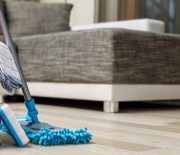Last update: 7 months ago

For generations, wooden furniture has been beloved for its ability to combine elegance with durability. The rustic charm and enduring elegance it brings captivate people. It holds a special place in the hearts and homes of Australians. As the years go by, the constant usage of these beloved pieces can lead to reduced shine. Things like dust, water stains, and a buildup of cleaning products can collect over time. Luckily, there is a natural way to clean them – vinegar.
Vinegar proves to be a cheap and harmless substitute for commercial cleaners. It efficiently removes dirt and rejuvenates wooden surfaces due to its acidic nature. It doesn’t contain the dangerous chemicals found in many commercial cleaners. So, if you find yourself in search of a solution on how to restore wood furniture with vinegar, look no more.
Can you clean wood with vinegar?
Wood surfaces can receive remarkable benefits from vinegar, especially white vinegar. With the proper dilutions, it is an excellent cleaner. It acts as a mild acid because of the acetic acid in it. It’s a powerful active ingredient that combats grime, grease, and buildup on wood surfaces. When gently applied to wood furniture, vinegar penetrates deep into the surface, diligently loosening stubborn dirt and grime. As a result, cleaning becomes easy.
Besides, wood should never be cleaned with harsh chemicals. Even commercial multipurpose cleaners are too strong. Use diluted vinegar to clean your wood furnishings. It will leave the wood surfaces clean and safe without the need for vigorous scrubbing.
Cleaning process using vinegar solutions
Using vinegar to clean wood furniture is not only effective but also eco-friendly. Plus, it’s available in most households. Learn how to clean wood furniture with vinegar and breathe new life into your favourite wooden pieces.
What you will need:
- Vinegar
- Olive oil
- Microfiber cloths
- Vacuum cleaner
Time:
- Preparation time – 5 minutes
- Active time – 30 minutes
- Total time – 35 minutes
Difficulty:
- Easy
Before starting the cleaning process, first evaluate the condition of your wood furniture. Take the time to identify any underlying problems. Choose the most suitable approaches for cleaning and restoring it accordingly.
- Scratches – Inspect the wood surface for any visible scratches or gouges.
- Watermarks – Look for light or dark spots caused by spills or moisture.
- Dull finishes – Assess the overall shine of the furniture.
- Cracks or damage – Check for cracks, chips, or warped surfaces.
- Previous treatments – Note any past treatments like varnish or wax.
- Overall condition – Step back and consider age and wear.
Wood furniture can be effectively and naturally cleaned with vinegar. It will not damage the material.
- Remove hardware and cushions – Set aside any cushions or pillows that may be resting on its surface. Remove any reinstallable hardware, like screws or decorative knobs. Don’t remove any hardware that holds the furniture together.
- Vacuum or dust the furniture – The surface should be clean. Dust off your wooden furniture with a vacuum cleaner.
- Clean cushions, if applicable – Before placing your cushions or pillows on your freshly cleaned wood furniture, you should first clean them. Check the labels on them for guidance on how to clean them properly.
- Dilute white vinegar with water – Use a 1:1 vinegar to water ratio for general cleaning. Add a small amount of mild-scented dish soap to the mixture to cover any vinegar odour.
- Clean with a damp cloth with the solution – Use a soft microfiber cloth in the vinegar solution and wring out the excess liquid. Gently wipe the wood surface with curricular motion. Avoid saturating the wood with the solution. Rinse the cloth when it becomes visibly dirty.
- Buff out excess moisture – Use a clean cloth to buff the wood in a circular motion. If you notice any spots that did not get cleaned, apply the cleaning solution and return to buffing. Finally, buff away any remaining moisture.
- Let it dry for about 30 minutes – Don’t sit on it for a few minutes to completely dry it. The furniture will appear newer, brighter, and less worn.
Include the cleaning of wood furniture with vinegar in your weekly regular cleaning schedule. Frequently dusting and wiping can help preserve your wooden furniture. A duster can make this process easier.
Treating water stains and polishing the wood
Water rings, scratches, and faded stains may make you believe your wood furniture is beyond repair. Before you throw it away, try some of the following simple, no-sanding-required tips for restoring wood furniture with vinegar and oil for furniture.
Removing water rings or stains from wood furniture
Given how frequently we use our wooden furniture, water stains are inevitable. Sadly, leaving hot or cold drinks on a wooden surface can leave unsightly rings or markings behind. Get rid of those pesky stains on your wooden furniture with this solution.
- Mix equal parts white vinegar and water in a bowl.
- Dab a soft microfiber cloth into the solution.
- Wring out any excess solution.
- Rub the water stain until it’s removed.
- Let it sit for a few minutes.
- Wipe off the mixture using another (clean) microfiber cloth.
- Dry thoroughly.
Polishing with an olive oil and vinegar mixture
Olive oil is a fantastic wood surface polishing product because of its special qualities. When applied gently, it seeps deeply into the fibres, causing them to swell and enrich their colour. This recipe is perfect for cleaning outdoor furniture with vinegar:
- Mix ¾ cup extra virgin olive with ¼ cup white vinegar.
- Apply it to the wooden surface with a microfiber cloth.
- Add a few drops of essential oil for scent (an optional step).
- Wipe your furniture clean.
- Buff off excess moisture with a dry cloth.
This mixture will revitalise a dried-out piece of wood. It is perfect for furniture that has little water damage but looks old and worn out because it’s been stored in the attic, garage, basement, or garage for too long.
Keep in mind that harsh cleaners and some furniture waxes and polishes can ruin the paint on wood furniture. So, when it comes to cleaning and polishing painted wood furniture, first regularly vacuum it with the brush attachment to prevent buildup. Then, use the above mixture to clean the furniture. Don’t neglect to wipe up the spills and crumbs immediately when you see them to prevent stickiness and stains.
Treating minor scratches
Wood tables, like all wooden furniture, are prone to scratches and damage. Daily use can cause scrapes and wear on the finish. Depending on how dark the finish is and how soft the wood is, the damage to your table may be more frequent or noticeable. It is easy to fix a minor scratch on a wood table. Mix ¾ cup of canola oil with ¼ cup of vinegar. Mix thoroughly and apply to scratch marks or minor damaged areas. The marks will gradually fade, and the wood will appear as good as new.
Takeaways
- Although there can be a lot of hesitation about how to restore wood furniture, actually, it’s quite simple. Just stick to gentle cleaning solutions like cleaning with vinegar, and never leave moisture on the wood.
- Remember, wood furniture looks elegant and sophisticated only when it’s properly cleaned.
- Know your limits, and don’t be afraid to seek expert assistance.
Having trouble finding the time to properly care for your wood furniture?
It’s no trouble at all. We’re here to help!








